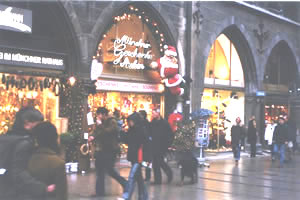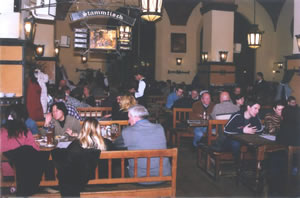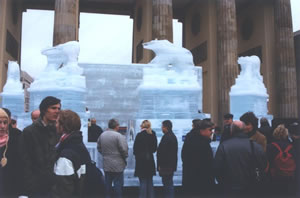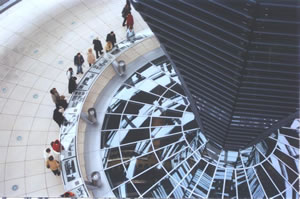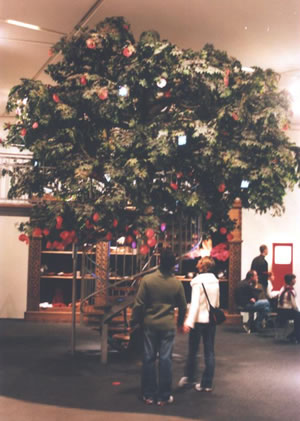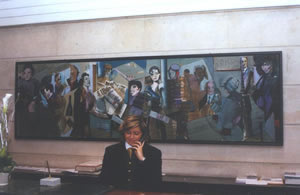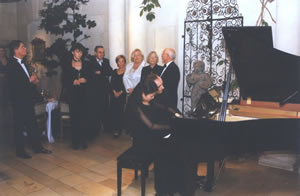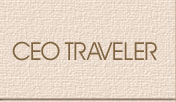 |
|
|
|
|
|
|
|
|
|
|
|
|
|
|
|
|
|
|
|
|
|
|
|
|
|
|
 |
 |
|
|
|
|
|
|
|
|
|
|
|
|

|
A Merry Christmas Holiday In Germany
Plan Ahead for Frohliche Weihnachten
No one does Christmas like the Germans. During Weihnachten the country is packaged with ribbons of light and wrappings of good cheer like a present for the imagination. People visit year after year knowing that this is the place where winter dreams really happen and the true Christmas can be found. The holiday season, about five weeks, starts at the beginning of Advent, four Sundays before Christmas Day, runs until Epiphany on January 6 and outlasts celebrations the world over. On the first Sunday German families hang wreaths into which four candles have been placed. One is lit each week until Christmas Day when a match is set to the last and largest. Christmas proper or Weinachtsfestagen is observed for three days beginning on Heiligabend, the 24th, when the tree (tannenbaum) is decorated and the most important festive meal is served. Weichnachstag, the 25th, is followed by Boxing Day on the 26th, known as the second day of Christmas. The weekend preceding Advent marks the opening of Germany’s renowned Weihnachtsmaerkte, which usually goes on until December 24. From the tiniest towns to the largest cities supporting almost a dozen fairs, over 2,500 Christmas Markets are scattered throughout the country. Dresden’s Steizenmarkt, the oldest one, dates from 1434, but because of the Nuremberg’s medieval character the red-roofed stalls of its Christkindlesmarkt draw the most visitors. Along with exquisite ornaments, fanciful toys, nativity figures and seductive sweets expect to find carousels, music, and entertainment amid a fairytale atmosphere. Many Christmas customs, which spread over the globe, originated in Germany. In the Middle Ages Germans would stage a mystery play on December 24 featuring a decorated evergreen representing the Tree of Life in the Garden of Eden. Martin Luther was said to have started the tradition of bringing a fir inside the house and decorating it with candles. The legend of Santa Claus derives from a tale about St. Nicholas, a 4th-century bishop who rode a white horse distributing gifts on the eve of his feast day, December 6. The hanging of stockings is attributed to St. Nick, too, as it is said that he dropped gold pieces down a chimney for three sisters who had no dowry and the money landed in a stocking that was hung out to dry. Weihnachtsmann or Father Christmas now appears on Christmas Eve (Heilgabend). The most famous of all Christmas carols, Silent Night, a translation of the original Stille Nacht, Heilege Nacht written 189 years ago, is sung in many languages all over the world. Foods most associated with the holiday -- ginger cookies; Dresden stollen, a sweetened bread filled with nuts, raisins, citron, and dried fruit; spice bars (lebkuchen); and marzipan -- appeared on German Christmas tables long ago. Decorated gingerbread houses, solid symbols of Christmas, resemble the one made of bread with a cake roof and sugar windows in the folktale (Marche) “Hansel and Gretel” written by Jacob and Wilhelm Grimm who grew up in Steinau. One of the most beloved seasonal entertainments, the ballet “The Nutcracker” has Germanic origins. The first wooden nutcrackers were carved at a major toy center, Erzgebirge in the western part of the country, and later appeared in Koenigsberg-born E. T. A. Hoffman’s fairy tale “Nussknacker und Mausekonig”
The Christmas tree comes down on January 6 after the Twelve Nights of Christmas. In German those 12 nights are referred to as “12 rauhnachte” (harsh nights). Indeed, the weather in December in this northern climate is mostly foul. The sky is gray. When it is not raining or snowing, it drizzles saturating the air with a damp chill. But it does not unhinge the spirit or crush the joyous atmosphere. The streets, shops, and cafes are crowded and lively with people bundled up for a stroll, hunting for the perfect gift or looking for a table at which to nibble on a wurst and sip a hot drink. And so we packed boots, heavy coats, wool scarves, fur hats and fur-lined gloves, sweaters, and thermals, along with evening clothes, and went off to Munich and Berlin to celebrate the end of 2004 in style. Not once did the weather interfere with our plans, including long walks to observe the street life. Munich The Lord Mayor of Munich (Munichen, meaning by the monk’s place) opens its Kripperlmarkt, specializing in cribs and Nativity items on Marienplatz on Friday evening before Advent. Thousands gather to watch the 2,500 candles on the 30-meter high tree being lit. Marienplatz is the city’s picturesque central square, a commercial and touristic crossroads and the site of the Town Hall ( Neues Rathaus) where the famed Glockenspiel revolves through a five-minute musical performance every day at 11 a.m. The carillon’s 43 bells peal while life-size coopers dance and knights joust. Munich, capital of Bavaria, was in 1945 a silent city as much of the medieval section had been destroyed during the bombing in World War ll. Having been rebuilt in the decades that followed, it looks as it did when the original buildings—palaces, castles and museums—were standing. It is an old-fashioned city without glass towers and modern architecture. Some of the natives, Muncheners, obligingly carry alpensticks and dress in loden cloth, Alpine felt hats stuck with badges and feathers, dirndl dresses, and lederhosen to do their bit to keep Bavarian folk fashions in vogue. For an orientation of central Munich take a one- and one-half hour tour leaving from Elison Strasse, around the corner from the train station. A three-hour tour follows the route of the shorter one and continues on to the park built for the 1972 Olympic Games For entertainment the simplest way to overcome the language barrier is to take in musical performances. At the edge of town in Theresienwiese Park, the site of the Tollwood Christmas Market, in the Amadeon tent in 2004 Gauklersonate (Juggler Sonata) played. In the musical Mozart dreamed of becoming a pop artist. Dressed in period clothing, he ran a large brush over a backdrop that lit up as he pretended to paint images in between each scene. You need not know a word of German to follow and enjoy the action. The Mozartband played the composer’s music in klezmer, jazz, and other styles. Acrobats, jugglers, clowns, and mimes acted out the story. Where To Stay
Along with a Christmas tree every hotel in Munich is decorated with the ubiquitous gingerbread house. At the Kempinski Hotel Vier Jarheszeiten an entire Bavarian village is formed from gingerbread and embellished with icing, candies, cookies, marzipan, and candied orange slices. Even a snow-capped mountain and an electric train are part of the scene. The tree festooned with tiny lights and red ornaments reaches to the center of a stained glass domed roof. The handsome wood-paneled lobby is a favorite of locals dressed in holiday finery and taking afternoon refreshments during the three days of Christmas. It is not hard to imagine the merriment of Christmases past that took place under the luminous ceiling dating from 1858 when hotelier August Schimon opened the hotel's doors on fashionable Maximilianstrasse and guests, including royalty, arrived in horse-drawn carriages. The neighbors were well-heeled, too. The Wittlebacker town house, now the sprawling Residence Museum with many wings filled with the family’s art and collectibles is down the street next to the lavish Opera. Today purveyors of international high-priced fashion and other luxury goods sell their wares on this boulevard. The atmosphere in the lobby is old world, but on the floors above tradition is tempered But perhaps what we enjoyed the most was the extravagant breakfast buffet. Sometimes hotel breakfasts are utilitarian, large quantities of food with little imagination. Not here. Think freshly squeezed kiwi juice; the best bread pudding, custardy egg bread topped with cherry sauce; an assortment of chewy dark breads and crusty rolls; unctuous smoked salmon with fresh radishes; and stolen dense with fruits and nuts and dusted with confectioners’ sugar. There were no chocolates on the pillow at turndown (we did receive a box on arrival) but who cared. Instead, we found an unexpected gift-wrapped stollen, worthy of taking home to remind us of the coddled experience in a grand hostelry. Kempinski Hotel Vier Jahreszeiten, Maximilianstrasse, 17 80539, Munchen. Tel 40 89 2125 2600 Where to Dine
The food prejudices we took with us that German food is heavy, consists mostly of starches and fatty meats, was disposed of at our first Christmas dinner on the 25th at Schwarz & Weiz in the new Dorint Sofitel Bayerpost Munchen Hotel. Converted from an old post office, the hotel is a juxtaposition of traditional and post-modern. From the outside the stone building appears as though it has been in this location for decades, which indeed it has. But inside the 75-foot atrium illuminated by a wall of light and the avant-garde décor is very much 21st century. The restaurant’s sleek environment called for updated food: very good gratineed scallops and a light celery soup. Fillet of beef was perfect. Undercooked roasted John Dory was sent back to the kitchen and was too dry when it was returned. The chef, Hans-Jurgen Gorsler, produced a lovely dessert worthy of a holiday dinner, fig pastry with mocha ice cream. We drank German wines, a fine Reisling from Rheingau and a Pinot Noir from Baden, one of the reds produced in limited quantities in this country. Service was superb. Schwarz & Wein, Dorint Bayerpost Sofitel Munchen Hotel, Bayerstrasse 12 80335, Munchen. Tel. 49 89 599480 Since Christmas stretches over three nights, Muncheners celebrate on the 26th, too, by dining out once more at top restaurants around town. That night we ate the special Weihnachtsmenu at the Mark Restaurant in the Mandarin Oriental Hotel. One of Munich’s best dining rooms; it has a creative chef, Mario Conti, who keeps reinventing classic dishes by using new ingredients and cooking techniques. Every tasty dish in our four-course dinner was accompanied by an appropriate wine. Since the cellar stocks 400 wines it wasn’t hard to do matchings that would please. Carpaccio of prawns was served with an Austrian wine that had a cantaloupe aroma. With halibut and shallot confit dressed with a thyme sauce, we drank a Rheingau Riesling with overtones of tangerine. A smooth Barbara d’ Alba went well with the whitest veal sitting in a puddle of truffle jus. And finally pear tarte with almond ice cream combined nicely with an Austrian Muskat with a hint of almonds. Mark is on the mezzanine floor and is reached by a sweeping curved marble columned staircase. Because the room overlooks the lobby, it has a very spacious feel. Handsome furnishings, china, cutlery, crystal and tablecloths as well as the distance between tables make for genteel surroundings. Small stools for women to rest their purses are placed at each table. A giant-sized raincoat and hat like Humphrey Bogart might have worn when playing a detective hangs in the lobby. It was placed there by the owner and certainly makes for a conversation piece. Mark Restaurant, Mandarin Oriental, Neuturmstrasse 1, 80331. Tel. 49 (89) 290 890. Berlin
The capital celebrates “WinterMagic Berlin” with over 500 events starting before Advent and running past Epiphany. The New Year’s Eve Silvester celebration at the Brandenburg Gate has fireworks, disco, entertainment on several stages, ice carvings, food and beer stands, and festive tents and draws a crowd of one million. At Potsdamer Platz people ski or toboggan down a 45-meter-long run covered with white powder snow. Among the forty Christmas Markets, the one on Gendarmenmarkt stays open till the end of the year. Three- to four-hour guided tours introduce visitors to the chief historic buildings. Buses line the Kurfurstendamnn, popularly known as the Ku’damm, the location at which most tourists board. You can get off and on along the way. We took the 1 ¾-hour “Berlin City Tour” opposite the Europa Center and close to KaDeWe allowing us a glimpse of the sites we wanted to see on our own and stopping only at Town Hall and the Brandenburg Gate. The guide spoke English and German and pointed out approximately 25 landmarks. The last one was the shattered hull of the 1895 Kaiser-Wilhelm Memorial Church. It was bombed in 1943 and left in a damaged condition as a reminder of the horrors of war. Along with culture, capitalism is flourishing. Prosperity and commerce co-mingle on the bright, crowded and lively Ku’Damm, a wide street established in the 1880’s and lined with cafes and elegant shops. Kaufhaus Des Westens (Ka DeWe), a bottomless emporium comparable to Harrods, symbolizes indulgence in an economically successful society. You can buy anything here, but the main attraction is the Feinschmeker (food lover) department with the largest collection of edibles under one roof in all of Europe. In the grand bazaar of food stands there are among other delights, 1,500 kinds of cheeses, 1,000 different sausages, 40 feet of yogurt displays and eggs from six varieties of chickens. There are also a dozen little restaurants or eating bars featuring specialties cooked every conceivable way. On a night when we had an early curtain, we ate a KaDeWe take-out supper of a dozen prepared items in our room. In the years since the wall came down, Berlin has had a rebirth as a great European center. It is a city on the edge, the cutting edge, and ranks as the most exciting among the world’s second tier cities--a wired San Francisco. The place to feel the pull of Berlin is at the Brandenburg Gate, crowned by a four-horse chariot driven by a winged goddess, Frederick the Great‘s symbol of 18th-century Prussia. On the other side of the Gate at Parizer Platz, Unter der Linden, Prussia’s grand boulevard, begins. To the north is the restored Reichstag, the house of parliament that Hitler’s thugs burned down in 1933. The original shell was gutted. Sir Norman Foster’s redesign of the building incorporating a greenhouse cupola matches the theme of transparency and makes the government accessible. The dome allows the seat of the government to be flooded with natural light during daytime hours. At times the wait to enter is quite long, but can be avoided by booking an English speaking group tour. Check for information at http://www.bundestag.de or fax a request to 49 0 30 227 30 027. Alternately dine at the roof garden restaurant to bypass the line. Reserve by phone at 49 0 30 22 62 99 33 or online at http://www.kaeferreservierung.com; berlin@feinkost-kaefer.de.
Karl Friedrich Schinkel, the 19th-century architect whose work put Berlin in the first rank of European classicism, is responsible for the Palace Bridge lined with romantic statuary, which leads from Unter der Linden to Museum Island, the place where Berlin was founded. The town has long been a culture capital with more world class museums than you could ever hope to see, many of them clustered on the island. Despite the richness of the collections in the Bode and Pergamon, the museum that invites the most attention is Daniel Liebeskind’s steely black creation, the Jewish Museum Berlin, modeled after a deconstructed Star of David. After its completion and before the installation of any exhibits, the zinc-paneled building with slats for windows attracted hundreds of thousands of visitors eager to see the bold architecture of points, mazes, and strange angles entwined so closely with the museum’s theme, “Two Millennia of German Jewish History,” from Roman times to the present. In these nooks Judaica and art and sculpture focus on ritual and daily life throughout the ages. A line of voids, a series of empty rooms, runs through Liebeskind’s building, symbolizing the banishment and murder of Jews during the war. On the lowest floor three axes intersect, one of continuity, another leading to the Garden of Exile and Emigration and a third to the Holocaust Tower, a bare, dark concrete room shut off from the outside world. When the wall fell Mitte (literally City Center), stretching from the Gate to Alexander Platz and formerly in the Russian zone, was very like a desert. A wrenching and exciting turnaround took place. The art scene began to emerge, techno music exploded, and Berlin solidified its position as ground zero for youth culture. The city’s vitality is easy to spot in Mitte where an extraordinary amount of artistic and cultural activity happens. There is always dancing, song, and music somewhere, particularly at this time of year. A highlight in seasonal family entertainment is the visit of the Roncalli Weihnactscircus, which continually tours Germany offering new themes and acts. During the last two weeks of ’04 the troupe appeared at the Berlin Tempodrum, the largest circus tent in Europe. The amusing Christmas program “Teatro Paradiso” featured clowns, comedy, acrobats, trapeze artists, jugglers, magicians, music, and festively costumed dancers. In '05 performances will take place between December 5 and January 6. http://www.roncalli.de.
Like the circus, opera is a medium with international appeal. Puccini’s Manon Lescaut debuted a few days before we went to see it at the Deutsche Opera, one of the city’s three opera houses. The modern building with big glass windows is unlike any we have visited in Europe. The opera was, of course, sung in Italian by singers with magnificent voices. If you read the synopsis before the performance, the story is easy to follow. In addition to the pleasure of listening to magnificent voices, the staging was superb. William Orlandi, the set and costume designer, impressed us with his minimalist modern sets and with the lavish period dress in which he clothed the troupe. Months after the curtain went down we could relive the opera by watching 30 slides from it on the opera’s website. http://www.deutscheoper.de When Berlin’s new Wintergarten Varieté Theatre opened in 1992 after a 56-year absence, Time Magazine called it an "international, multicultural theater event, a program without language barriers that will thus draw audiences from all over the world.” The original Wintergarten, dating from the 1880s was a "Jardin de plaisanterie" a glass palace-like garden auditorium, with palm trees, fountains and grottoes for dining and shows. Today up to 500 spectators enjoy performances presented by impresario Peter Schwenkow, which change bi-monthly. According to Bernhard Paul, director of the Circus Roncalli, varieté is "the delicate little brother of circus." He joined the Wintergarten at the beginning and is involved in helping shape a “mixture of theatre and revue, circus and cabaret, parody and artistry, art and skill, comic and thrill. Amazing manipulations, poet acts, comical figures, world class acrobats, and top artists with stunning skills and abilities to entertain spectators from all over the world - with or without words.” The auditorium was built to resemble the old Wintergarten and is decorated with selected keepsakes in the private boxes. Just as it was in the old theatre more than 100 years ago, the ceiling is arched over by the "Starry Sky” with lights twinkling in different sizes and intensity. Glass display cases were built on the walls and underneath the stairs to showcase an exhibition of pieces from the circus and varieté, props known as the Roncalli collection.The restaurant offers a choice of menus ranging from evening to late-night dinners after the show. Snacks, dinners, and drinks are served during the performance and the break Circo Massimo starring Massimo Rocchi, the “one-man circus,” as well as others, will have a three-month run during the winter holidays in 2005. Where To Stay
The doyen of Berlin hotels, the Bristol Kempinski, is a conscious remembrance of things past. In 1872 the Kempinskis opened an eponymous restaurant, which later became the most famous one in the city. The business moved several times, finally occupying the landmark corner on the Ku’damm. The family was forced to divest themselves of ownership in 1937 and during the war their building was destroyed. When the hostilities ended, the family returned and built a distinctive semi-circular hotel in 1953 on the site of their old property, adding the name Bristol. During the cold war when West Berlin was an island in the communist matrix, the Kempinski hosted diplomats, businessmen, entertainers, and movers and shakers. Some of the famous faces appear in a mural in the reception area. The rooms are gradually being done over. We inspected an updated one, which was cheerier than the room in which we stayed. A section of the Garden Room where the breakfast buffet is served has solar windows. The oval swimming pool in the spa is one of the most attractive we’ve seen in a hotel. The Grill restaurant serves reliable food, but that doesn’t stop the chef from pulling some nouvelle and sophisticated tricks out of his toque. Packages through the Christmas season include tickets to the musical, The Three Muscateers, and to the Blue Man Group. Kempinski Hotel Bristol, Kurfurstendamm 27, 10719 Berlin. Tel. 49 30 8843 4856 On a quiet plaza in from the Ku’damm, the Steigenberger Berlin is altogether modern with an airy interior. In summer, the block-sized Los Angeles Platz across from the entrance becomes a tranquil urban oasis with leafy linden trees, green lawns and blossoming gardens.
Our suite, really more of an apartment, was so light and cheerful that were it not for the powerful pull of Berlin, one would have been tempted to settle in and linger for awhile. Unlike so many foreign hotels, the lighting was bright enough to read by deep into the night. Although our quarters were not on the executive floor, the club guest services—clothes pressing, shoe polishing, daily newspaper and late check-out-- were extended to us. The 9th-floor club lounge with a beautiful panoramic view over the city rooftops offered food service three times a day. Best of all was the evening buffet--meatballs, filet of beef, quiche, potato croquettes as well as cheese, vegetables, bread and fruit--could substitute for dinner for those with an early curtain. Alcoholic drinks at no charge are offered throughout the day. You could take breakfast in the lounge, but the buffet in the Berliner Stube, included with weekend stays, offered a gargantuan selection of tasty food. The head chef, Holger Zurbruggen, oversees the hotel’s most formal restaurant, Louis, and his culinary skill spills over to all venues where meals are served. As part of a refurbishment several years ago the fitness facilities were updated. A circular pool under a rotunda has a bar with an attendant to serve you vitamin drinks and snacks. When the weather gets warm lounging chairs can be moved outside on the terrace. Chicago during Prohibition was the theme for the Silvester (New Year’s Eve, 2004) party. The ballroom and its foyer were kept under wraps until the guests arrived. And it certainly was authentic. Wooden cratesused by bootleggers and period posters were a few of the imaginative decorations. In 2005 the theme will be “Maharadschas Garden” and it will be a great oriental party with special decorations, oriental music, a “Hindu-Bar”, artists in national costumes, a “maharadscha buffet,” and an oriental Bazaar with market stalls. Steigenberger Hotel Berlin, Los-Angeles-Platz 1, 10789, Berlin. Tel. 49 30 2127733.
One of Berlin’s most elegant Silvester celebrations takes place at the Hotel Brandenburger Hof. A little over 100 schickeria (derived from chic and refers to the smart set) were there. Most were hotel guests who took advantage of a three-day Neujahrs package, which included a concert at the Berlin Philharmonic conducted by Sir Simon Rattle on the 30th. On the 31st revelers dressed in black tie arrived at 7:00 for champagne and sumptuous appetizers set out on a buffet table including celebratory foods like, caviar, lobster, foie gras, salmon and oysters. The hotel’s restaurant Die Quadriga has one Michelin star and is ranked among the top ten in Berlin in the luxury category. Following a greeting by Mrs. Daniela Sauter, owner of the property, guests assembled in the Wintergarden to listen to two pianists, Yelena and Schmidt, play duets on one piano. The five-course meal stood up to the enchantment of the evening. Langustino with leeks and hazelnuts was appealingly classic and straightforward. Fois gras and white cabbage gave pheasant essence extra personality. The flavors of celeriac and truffles dressed up a perfectly steamed turbot. Filet of beef napped with wine and vinegar sauce was as good as any beef lover could wish for. The dessert buffet, anointed with cakes, tarts, pastries, and ice creams offered some standards and some surprises like pepper ice cream. Quadriga has one of the most outstanding wine cellars in Germany with 850 bottles that come from the country’s own vineyards. Wine Spectator said it has one of the 500 best wine lists in the world. As was to be expected the wines that were served were outstanding.
At midnight champagne glasses were filled once more and fireworks were lit in the Hofgarten. Everyone, including staff, went out on Eislebener Stasse to watch the colorful show in the sky. Dancing to live swing followed. It was one of the most memorable New Year’s Eves, oops I mean Silvesters, we’ve every spent. Our tablemates were conversant and well traveled. I have to confess that they were English, but we would have had the same wonderful experience with the German guests who were very friendly. And it definitely was more than worth it, even for people like us who are light packers, to travel with formal clothing. Hotel Brandenburger Hof, Eislebener Strasse 14 10789, Berlin-Wilmersdorf. Tel. 30 2 14 05 - 6 50 How To Reach Germany The experience in Lufthansa’s Business Class is a very good one with many pluses not found on other carriers. The Senator lounges are larger than any we ever sat in. Supposedly, Senator is for First Class and Business Class has a separate lounge. However, we were directed to the Senator lounges at JFK and in Frankfurt while waiting to change planes. No crowding here, food that was ample and tasty, and in Europe a separate section for smokers was far away from the one for non-smokers. The lounges also have free wireless access. The seats are a full two-meters and the 9-degree incline makes them almost as flat as a bed and are reasonably comfortable on a long haul. They have remote memory functions to store desired reading and sleeping positions, integrated back massage function, foldaway privacy screens, adjustable reading lights, flexible/adjustable headrests and retractable armrests. The entertainment portal FlyNet has news, travel information, and language instruction as well as virtual blinkers that block video from other passengers. Connoisseurs on Board features international cuisine from several chefs. On one leg we were fed selections from the Adler in Asberg and on the other from Trofana Royal in Tirol. The menus include information about the chefs, their restaurants, and a recipe. The sommelier for the wine program has assembled a small, but commendable list from several countries. 800-645-3880 Fall 2005 |
||||||||||||||||||||||||

